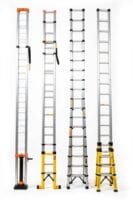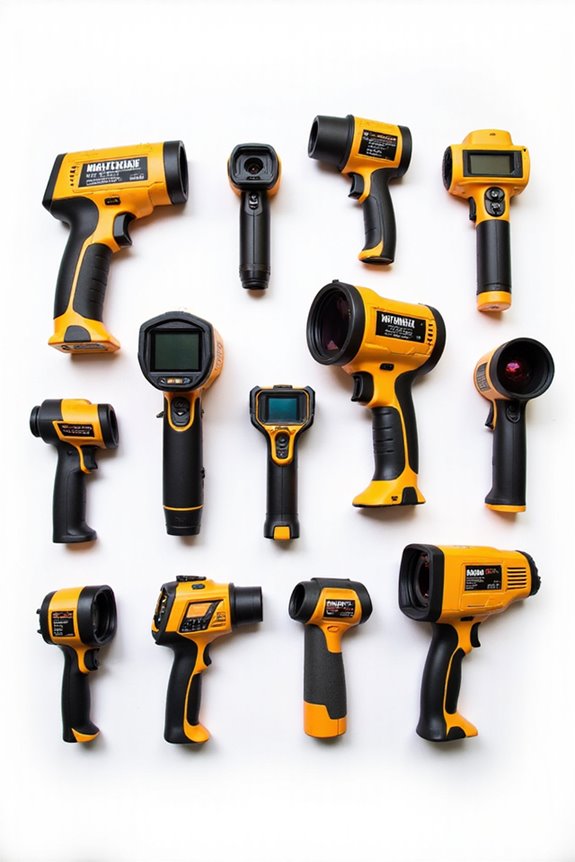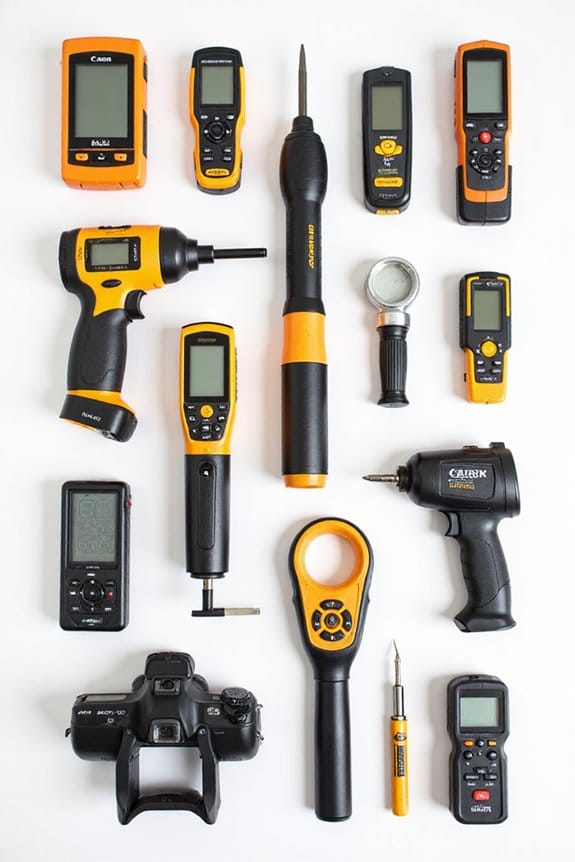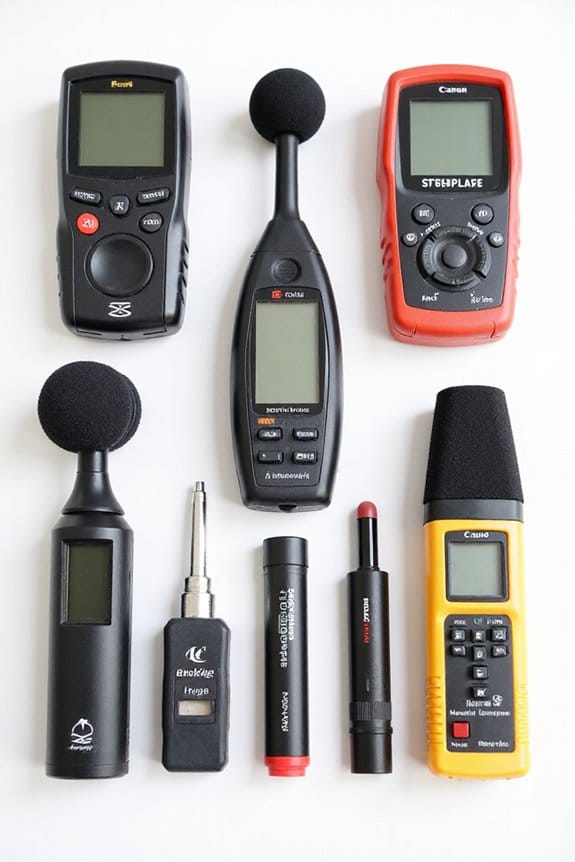As an Amazon Associate, we earn from qualifying purchases. Some links may be affiliate links at no extra cost to you. Although our opinions are based on curated research, we haven't used these products. Articles generated with AI.

7 Best Non-Contact Voltage Testers to Keep Your Electrical Work Safe and Efficient
When you’re tackling electrical work, safety is key. Here are the 7 best non-contact voltage testers to evaluate: 1) Fluke 2AC Alert for high voltage detection, 2) Non-Contact Dual Range for versatility, 3) Adjustable Sensitivity models for precise needs, 4) 2 Pack testers for added value, 5) Southwire for simple functionality, 6) Fluke 1AC II for reliable alerts, and 7) KAIWEETS with an LCD display for ease of use. Stick around, and you’ll discover what to look for in your next tester!
Key Takeaways
- Non-contact voltage testers allow for safe voltage detection without physical contact, reducing the risk of electrical shock.
- Look for adjustable sensitivity settings to accurately detect different voltage levels from 12V to 1000V AC.
- Compact designs often come with built-in LED flashlights, enhancing visibility during electrical inspections in low light conditions.
- Consider models with audible alarms and visual indicators for instant feedback on voltage presence, increasing safety and efficiency.
- Reliability and durability are essential; premium options often offer enhanced features and longer-lasting performance, making them suitable for professionals.
Fluke 2AC Alert Voltage Tester
Sale
Fluke 2AC Alert Voltage Tester
- Voltbeat technology and continuous self test so you always know it is working
- Upon detection, tip glows
- Non-contact voltage detection from 90 to 1000 V ac
If you’re an electrician or a DIY enthusiast, the Fluke 2AC Alert Voltage Tester deserves a spot in your toolkit. This pocket-sized, non-contact tester uses Voltbeat technology to guarantee it’s always ready to work. Here’s why it’s worth your attention:
- Wide Voltage Range: It detects voltages from 90 to 1000 V AC—perfect for various applications.
- Live Voltage Indicator: A glowing tip shows you when you’re near live wires—safety first!
- Compact: Its portability means you can take it everywhere you go.
With a long-lasting battery life and robust reliability, it’s a smart choice for any electrical task.
Best For: Electricians and DIY enthusiasts looking for a reliable and portable voltage tester.
Pros:
- Compact and portable design makes it easy to carry for on-the-go use.
- Wide voltage detection range from 90 to 1000 V AC suitable for various applications.
- Continuous self-test technology ensures consistent functionality and reliability.
Cons:
- Non-contact testing may not detect very low voltages effectively.
- Limited to AC voltage detection, so not suitable for DC applications.
- Some users may find it overly sensitive to interference in certain environments.
Voltage Tester, Non-Contact Dual Range Electrical Tester
NJTY Voltage Tester,Non Contact Voltage Tester,12V-1000V/48V-1000V Dual Range,Electrical...
- Advanced Detection Technology: NJTY electrical test pen features cutting-edge Non-Contact Voltage (NCV) detection, ensuring faster, more accurate, and safer voltage...
- Adjustable Sensitivity Modes: Tailor your testing needs with two sensitivity options. Choose "High" sensitivity for a range of 12 V-1000 V or "Low" sensitivity for 48...
- Efficient & Energy-Saving: Detect circuit breaks in real-time and swiftly identify electrical issues with the Voltage Tester Pen. Its smart design includes an automatic...
The Non-Contact Dual Range Electrical Tester shines as an essential tool for homeowners and DIY enthusiasts alike, especially when safety is the top priority. This nifty gadget offers dual ranges: 12V-1000V for high sensitivity and 48V-1000V for low sensitivity.
Here’s why you’ll love it:
- Convenient Features: An LED flashlight and red indicator light help you see what you’re doing.
- Smart Design: It shuts down automatically after five minutes of inactivity to save battery.
- User-Friendly: Clear results and a handy manual make it easy to use.
Just remember, it might take a second to power on—patience is a virtue!
Best For: Homeowners and DIY enthusiasts looking for a reliable tool to identify live wires safely.
Pros:
- Convenient features like an integrated LED flashlight and red indicator light enhance usability.
- Automatic shutoff after five minutes conserves battery life, increasing device longevity.
- Dual sensitivity ranges allow for versatile applications in various electrical tasks.
Cons:
- Some users reported a slight delay when powering on the device.
- The flashlight feature may be preferred by some users to be replaced with an instant-on laser feature.
- Detection of GFCI receptacles may not be as effective as standard outlets, leading to possible usability concerns.
Non-Contact Voltage Tester with Adjustable Sensitivity
Auroland Non-Contact Voltage Tester with 9 Gear Adjustable Sensitivity Voltage Detector AC Circuit...
- [Non-contact AC Voltage Tester]: This test pen has NCV sensor, you can detect the presence of AC voltage by simply pressing the power switch and bring the probe of the...
- [Alarm function]: When the AC voltage is detected, the sensor indicator lamp of the tester blinks. The test pen lights up the corresponding signal strength indicator...
- [Adjustable Measurement Range]: The HANMATEK non-contact AC tester can adjust the gear in 9 steps, and the detection range can be freely switched between 12-1000v and...
Looking for a tool that fits both DIY enthusiasts and professionals alike? The Non-Contact Voltage Tester with Adjustable Sensitivity might be your perfect match! Here’s why:
- Versatile Detection: This tester detects AC voltage by simply bringing it close to power outlets.
- Customizable Sensitivity: Adjust the measurement range in nine steps from 12-1000V, making it flexible for various tasks.
- User Alerts: It features an alarm with lights and sounds to alert you about the voltage level.
- Compact and Portable: Its design makes it easy to carry around for projects.
Just remember, while it’s a handy device, durability might not satisfy extreme users.
Best For: This product is best for DIY enthusiasts and casual users looking for an affordable and handy voltage detection tool.
Pros:
- Versatile Detection: Effectively detects AC voltage from power outlets and live wires through insulation.
- Adjustable Sensitivity: Allows customization of the measurement range to suit various applications.
- Compact Design: Easy to carry around for on-the-go projects.
Cons:
- Durability Issues: Some users report concerns regarding the casing and reliability during professional use.
- Instruction Clarity: Instructions may be difficult to read due to small font size, requiring additional tools for clarity.
- False Readings: Reports of false positives could be a concern for professionals seeking accurate results.
2 Pack Non-Contact Voltage Detector and Electrical Tester
2 Pack Non-Contact Voltage Detector, Voltage Tester Electrical Tester, AC 12V/48V/70V-1000V, Wire...
- 【Non-contact Voltage Tester】 Ranging 12-1000V AC, You can easily distinguish the live and null wire through different level of alarm sound and LED indicator.
- 【Safe and Convenient】The voltage pen tester detectes voltage in a non-contact way, which provides you with the easiest and safest way to check the voltage in a wire,...
- 【3 Buzzer Modes】The live wire voltage tester is designed with 3 buzzer modes that suit for different voltage detection ranges. After powering on, the default is low...
When you need to tackle electrical projects without worrying about live wires, the 2 Pack Non-Contact Voltage Detector and Electrical Tester is your dependable partner. Here’s why you’ll want to keep it handy:
- Versatile Voltage Detection: It tests AC voltages from 12V to 1000V, covering a wide range of applications.
- Safety First: Non-contact detection guarantees you can safely distinguish live wires from dead ones using an alarm and LED indicator.
- Custom Sensitivity: Choose from three sensitivity modes to match your needs, buzzing differently based on voltage levels.
- Convenient Features: Its built-in flashlight helps you work in dim areas.
With some mixed reviews, this tool is compact and user-friendly, making it a solid addition to your toolkit!
Best For: This product is best for DIY enthusiasts and professionals looking for a reliable and safe tool to detect electrical voltage without direct contact.
Pros:
- Versatile voltage detection for a wide range of applications (12V to 1000V).
- Non-contact operation ensures safe identification of live and null wires.
- Compact and portable design with a built-in flashlight for use in dark environments.
Cons:
- Mixed reviews on functionality and usability, leading to user distrust.
- Lack of clear instructions could hinder user experience, especially for beginners.
- Issues with automatic shut-off may affect convenience during longer tasks.
Southwire Tools 40116N NCV Detector 100-600V AC
Sale
Southwire Tools 40116N NCV Detector 100-600V AC
- Southwire Pen style voltage tester
- AUDIBLE AND VISUAL INDICATION of AC voltage from 100-600V AC
- INCREASED BATTERY LIFE: the auto power off feature increases the battery life by powering off after 5 minuets of inactivity
For electricians and DIY enthusiasts, the Southwire Tools 40116N NCV Detector is a smart choice when it comes to non-contact voltage testing. Here are its highlights:
- Voltage Range: Detects AC voltage from 100-600V—perfect for most household needs.
- User-Friendly: Simple design with an on/off switch and clear indicator lights.
- Audible Alerts: Long beeps and flashing red confirm detected voltage.
- Compact Design: Sturdy pen-style tester fits right in your pocket.
- Safety First: CAT IV 600V rating guarantees you’re working safely.
Give it a try! You might find it outperforms your current go-to testers.
Best For: Ideal for electricians and DIY enthusiasts seeking a reliable non-contact voltage tester for a variety of applications.
Pros:
- Highly sensitive: Detects voltage accurately, reducing the chance of missed detection.
- Compact and durable design: Conveniently portable while maintaining robust quality.
- Audible and visual alerts: Provides clear indications of voltage presence for enhanced user awareness.
Cons:
- May produce false positives: Can occasionally signal voltage where there is none, especially when nearby.
- Not suitable for TR outlets: Limited compatibility with Tamper Resistant outlets may restrict use in certain settings.
- No dedicated flashlight switch: Combining flashlight and tester functions can be less intuitive for some users.
Fluke 1AC II VoltAlert Non-Contact Voltage Tester
Sale
Acv Detector 90-1000V
- Be aware of voltage easily - the tip glows red and a beeper sounds when voltage is detected
- Continuous self-test so you always know it’s working
- Voltage detection range for wide application use - 90 V to 1000 V AC or 200 V to 1000 V AC
Electricians and maintenance professionals converge on the Fluke 1AC II VoltAlert Non-Contact Voltage Tester for its impressive reliability and safety features. Here’s why you might consider adding it to your toolkit:
- Detection Range: It detects AC voltage from 90-1000V, helping you tackle various jobs.
- Safety Rating: With a CAT IV safety rating, you can work confidently.
- Self-Test: It features continuous self-testing to guarantee the device is always operational.
- Audible & Silent Modes: You can switch between audible alerts or silent mode—whatever suits your style!
Compact and effective, this tester is a favorite among professionals for good reason. Trust it to keep you safe from surprises!
Best For: The Fluke 1AC II VoltAlert Non-Contact Voltage Tester is best for electricians, maintenance workers, and safety personnel who need a reliable tool for detecting live voltage in various settings.
Pros:
- Compact design makes it easy to carry and use in tight spaces.
- Continuous self-testing ensures operational reliability and safety.
- High detection range (90-1000V AC) suits a variety of electrical tasks.
Cons:
- Some users have reported issues with clips breaking after extended use.
- Limited durability of the clips has been a common feedback point.
- No replaceable housing option for the device may be a concern for long-term use.
KAIWEETS Non-Contact Voltage Tester with LCD Display
Sale
KAIWEETS Voltage Tester/Non-Contact Voltage Tester with Signal Percentage, Dual Range AC...
- SAFETY FIRST: It will send out multiple alarms through sound and light. When the voltage is detected, the tip will send out red light and beep. When the higher the sensed...
- NON-CONTACT: With NCV inductive probe for AC voltage; Just place the tip near a terminal strip, outlet, or supply cord. When the tip glows red and the pen beeps, you know...
- DUAL RANGE: Detects standard and low voltage (12-1000V AC / 70-1000V AC) for more sensitive and flexible measurements. Press the S button to adjust sensitivity and adapt...
If you’re a DIY enthusiast or just someone who wants to tackle basic electrical tasks safely, the KAIWEETS Non-Contact Voltage Tester with LCD Display is an excellent choice. Here’s what makes it stand out:
- Dual Voltage Range: It detects AC voltage from 12V to 1000V, perfect for various applications.
- LCD Display: An intuitive digital readout shows voltage intensity as a percentage.
- Safety Alerts: You’ll get visual and audible alarms for high and low voltage, keeping you informed.
- User-Friendly Design: A compact form with a flashlight makes it easy to carry and use in tight spots.
Just remember, a voltage tester is your buddy, not a substitute for careful electrical work!
Best For: DIY enthusiasts and individuals looking for a safe and reliable tool to perform basic electrical tasks.
Pros:
- Dual voltage detection for a wide range of applications, from 12V to 1000V.
- Intuitive LCD display provides clear voltage intensity readout.
- Safety alerts with both visual and audible signals enhance user safety.
Cons:
- The beeping alarm may be excessively loud for some users without volume control options.
- Some users reported issues with rechargeable batteries, preferring alkaline options instead.
- Caution is advised as the device should not be the only tool relied upon for voltage detection.
Factors to Consider When Choosing a Non-Contact Voltage Tester
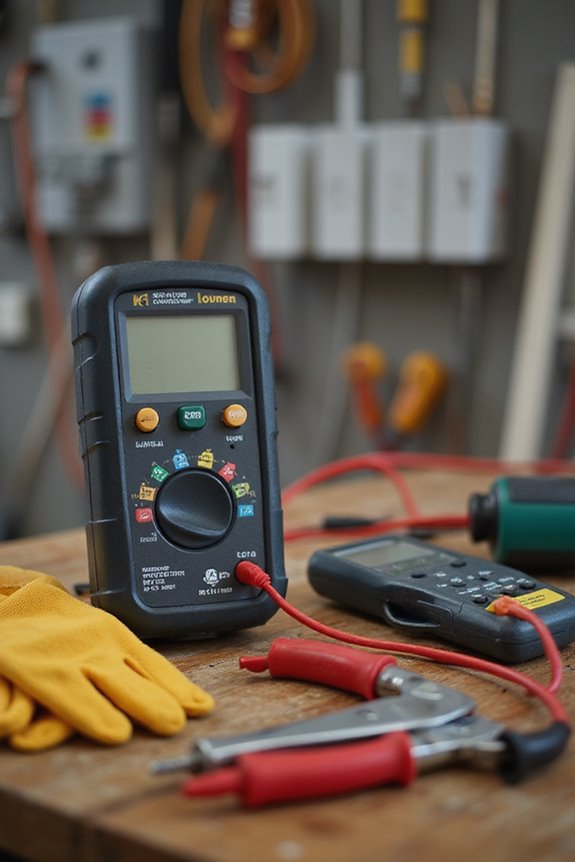
When picking a non-contact voltage tester, there are several key factors to keep in mind. You’ll want to evaluate the detection range options, sensitivity settings, and even the type of power source it uses. A tester’s durability and safety ratings can make a big difference in how well it performs, so don’t skip that part!
Detection Range Options
Choosing the right detection range for a non-contact voltage tester can make all the difference in your electrical projects. Here are a few factors to take into account:
- Voltage Range: Look for testers with detection ranges between 12V to 1000V AC. This versatility lets you handle various jobs, from checking outlets to inspecting industrial setups.
- Thresholds: Some testers have specific thresholds, like 90V to 1000V AC, ensuring you can tackle both residential and commercial work safely.
- Distance Detection: Enhanced capabilities help identify voltage from a distance, reducing the risk of contact with live wires.
Ultimately, selecting a tester with an appropriate detection range makes your projects safer and more efficient. And hey, who wouldn’t want that?
Sensitivity Settings Availability
Sensitivity settings are an essential feature to contemplate in non-contact voltage testers. They let you toggle between low, medium, and high sensitivity, customizing your testing based on the task. Here are a few reasons to pay attention:
- Accuracy: Adjustable settings help reduce false positives near live wires. You’ll get more reliable readings.
- Voltage thresholds: Testers often offer specific ranges, from 12V to 1000V. This means less guessing on what you’ll encounter.
- Distance matters: Enhanced sensitivity can detect voltage from further away, boosting your safety.
- Signals: Look for testers with visual and auditory cues reflecting different sensitivity levels. They’ll help you gauge voltage presence quickly.
Power Source Type
Power source type plays an essential role in selecting the right non-contact voltage tester for your needs. Here are some key points to reflect on:
- Battery Operated: Most testers run on standard batteries like AAA or 9V, making replacements easy.
- Battery Life: Look for models with low power circuitry that extends battery life. Nobody wants their tester dying mid-job, right?
- Automatic Shutdown: Some testers feature automatic shutdown to save energy. This is a handy feature that prevents battery drain when you forget to turn it off.
- Convenience: Choosing testers with easily available batteries adds to the overall convenience.
Durability and Build Quality
When you’re picking out a non-contact voltage tester, durability and build quality aren’t just about keeping the device intact—they’re about ensuring that your investment lasts. Here are a few factors to evaluate:
- Material Thickness: A thicker casing generally means better protection against wear and tear.
- Sturdy Design: Look for testers with a robust design that can withstand drops and impacts—after all, your gadget deserves a tough exterior!
- User Reports: Check reviews for insights into longevity; many users rave about their testers still holding strong after years of use.
- Reliable Sensors: A quality tester should minimize false readings, indicating a dependable internal system.
- Auto Power-Off: A thoughtful design feature that saves battery life and adds to durability.
Safety Ratings Consideration
Although selecting a non-contact voltage tester might seem straightforward, understanding safety ratings is vital for ensuring you pick the right tool for your electrical tasks. Here are key factors to evaluate:
- CAT Ratings: Look for at least a CAT III rating for standard use. If you work with high voltages, a CAT IV rating is vital for safety up to 1000V.
- UL Listing: Choose testers that are UL listed. This means they’ve passed rigorous safety standards, giving you peace of mind.
- Auto Power-Off: Opt for testers with this feature. It minimizes accidental discharges and helps conserve battery life.
- Indicators: Clear visual and audible alerts are a must. They help you avoid potential accidents during work. Safety first!
Usability and Design Features
Choosing the right non-contact voltage tester isn’t just about safety ratings; the usability and design features can make a world of difference during your electrical tasks. Here are some key factors to take into account:
- Compact and Lightweight: A portable design guarantees it fits snugly in your toolbelt, so you won’t feel like you’re lugging around a brick.
- Adjustable Sensitivity: This feature helps tailor voltage detection, reducing those pesky false positives.
- Integrated LED Flashlight: If you’ve ever fumbled in the dark, you know how handy this can be.
- Clear Visual Indicators: Bright LEDs or an LCD display give you immediate feedback—no squinting required!
- Automatic Power-Off: Your batteries will thank you. Less need for replacements? Yes, please!
Additional Functions Included
While you might think basic voltage detection is all you need, choosing a non-contact voltage tester with additional functions can enhance your overall experience. Here are some cool features to look for:
- LED Flashlight: Great for low-light conditions, making those tricky inspections a breeze.
- Adjustable Sensitivity: Tailor responsiveness to different voltages, ensuring accurate readings no matter where you are.
- Digital Readout: Provides clear voltage readings for quick assessments—no more squinting at tiny prints!
- Audible Alarms: Instant feedback on voltage presence boosts safety. You’ll appreciate that “beep”!
- Energy-Saving Mode: Automatic shutdown prolongs battery life, keeping your tester ready when you are.
With these features, you’ll work safer and smarter!
Price and Value Comparison
Investing in a non-contact voltage tester means weighing price against value to find the best fit for your needs. Here are some pointers to guide your choice:
- Budget Options ($8 – $20): Great for casual users, these testers often include essential features like audible alarms and LED indicators.
- Mid-Range ($20 – $35): For the serious hobbyist or professional, these models offer adjustable sensitivity and dual voltage ranges, which can make your work easier.
- Premium Models ($35+): If you’re in it for the long haul, consider enhanced durability and advanced features like LCD displays and built-in flashlights.
Remember to factor in reliability, warranty, and user feedback. It’s worth spending a bit more for quality when it counts!
Frequently Asked Questions
How Do I Calibrate My Non-Contact Voltage Tester?
Calibrating your non-contact voltage tester is pretty simple. Follow these steps:
- Power On: Turn on your tester and verify it’s functioning. You don’t want surprises, right?
- Test Voltage Source: Bring it close to a known live wire. If it beeps or lights up, it’s working.
- Adjust Settings: Some testers have sensitivity settings. Experiment to see what works best for your environment.
Are Non-Contact Voltage Testers Safe for Outdoor Use?
Imagine your voltage tester as a trusty umbrella in a storm; it keeps you safe while you work. Yes, non-contact voltage testers are generally safe for outdoor use, but here’s what you need to keep in mind:
- IP Rating: Look for an IP-rated tester.
- Weather Conditions: Avoid using it during heavy rain or extreme weather.
- Power Lines: Stay alert around power lines.
It’s like a superhero for your toolbox—making safety a priority!
Can These Testers Detect DC Voltage as Well?
Non-contact voltage testers are great, but they usually can’t detect DC voltage. Here’s why:
- Designed for AC: Most testers target alternating current, which is common in household wiring.
- Limited range: While some advanced models claim to detect DC, it’s rare. Always check the specifications!
What Is the Average Lifespan of a Non-Contact Voltage Tester?
The average lifespan of a non-contact voltage tester is about 2 to 5 years, depending on usage and care. Here’s a quick breakdown:
- Regular Use: Testers that you use frequently may wear out faster.
- Battery Maintenance: Replace batteries promptly to keep it functioning well.
- Dropping and Damage: Handle it with care—no one likes a clumsy tester!
How Often Should I Replace My Non-Contact Voltage Tester?
How often should you replace your non-contact voltage tester? Well, it really depends! Here are a few guidelines:
- Every 2-3 years – Technology evolves, and newer models can be more accurate and efficient.
- After drops or damage – If it’s fallen, it might not be reliable anymore.
- Calibration issues – If you notice inconsistent readings, it’s time for a change.
Stay safe out there, and remember: testing your tools is just as important as testing the voltage!



